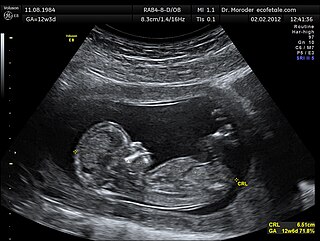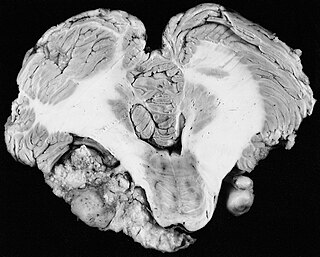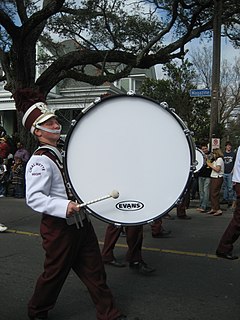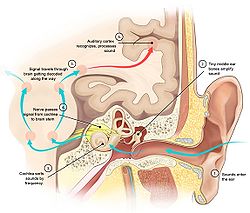
Ultrasound is sound waves with frequencies higher than the upper audible limit of human hearing. Ultrasound is not different from "normal" (audible) sound in its physical properties, except that humans cannot hear it. This limit varies from person to person and is approximately 20 kilohertz in healthy young adults. Ultrasound devices operate with frequencies from 20 kHz up to several gigahertz.

A tin foil hat is a hat made from one or more sheets of aluminium foil, or a piece of conventional headgear lined with foil, often worn in the belief or hope that it shields the brain from threats such as electromagnetic fields, mind control, and mind reading. The notion of wearing homemade headgear for such protection has become a popular stereotype and byword for paranoia, persecutory delusions, and belief in pseudoscience and conspiracy theories.
The microwave auditory effect, also known as the microwave hearing effect or the Frey effect, consists of the human perception of audible clicks, or even speech, induced by pulsed or modulated radio frequencies. The communications are generated directly inside the human head without the need of any receiving electronic device. The effect was first reported by persons working in the vicinity of radar transponders during World War II. In 1961, the American neuroscientist Allan H. Frey studied this phenomenon and was the first to publish information on the nature of the microwave auditory effect. The cause is thought to be thermoelastic expansion of portions of the auditory apparatus, although competing theories explain the results of holographic interferometry tests differently.

Echolocation, also called bio sonar, is a biological sonar used by several animal species. Echolocating animals emit calls out to the environment and listen to the echoes of those calls that return from various objects near them. They use these echoes to locate and identify the objects. Echolocation is used for navigation, foraging, and hunting in various environments.

Tinnitus is the perception of sound when no corresponding external sound is present. Nearly everyone will experience a faint "normal tinnitus" in a completely quiet room but it is only of concern if it is bothersome or interferes with normal hearing or correlated with other problems. While often described as a ringing, it may also sound like a clicking, buzzing, hiss, or roaring. The sound may be soft or loud, low or high pitched, and often appears to be coming from one or both ears or from the head itself. In some people, the sound may interfere with concentration and in some cases it is associated with anxiety and depression. Tinnitus is usually associated with some degree of hearing loss and with decreased understanding in noise. It is common, affecting about 10–15% of people. Most, however, tolerate it well, and it is a significant problem in only 1–2% of people. The word tinnitus comes from the Latin tinnire which means "to ring".
A gravastar is an object hypothesized in astrophysics by Pawel O. Mazur and Emil Mottola as an alternative to the black hole theory. It has usual black hole metric outside of the horizon, but de Sitter metric inside. On the horizon there is a thin shell of matter. The term "gravastar" is a portmanteau of the words "gravitational vacuum star".

The internal capsule is a white matter structure situated in the inferomedial part of each cerebral hemisphere of the brain. It carries information past the basal ganglia, separating the caudate nucleus and the thalamus from the putamen and the globus pallidus. The internal capsule contains both ascending and descending axons, going to and coming from the cerebral cortex. It also separates the caudate nucleus and the putamen in the dorsal striatum, a brain region involved in motor and reward pathways.

Sonification is the use of non-speech audio to convey information or perceptualize data. Auditory perception has advantages in temporal, spatial, amplitude, and frequency resolution that open possibilities as an alternative or complement to visualization techniques.

A vestibular schwannoma (VS) is a benign primary intracranial tumor of the myelin-forming cells of the vestibulocochlear nerve. A type of schwannoma, this tumor arises from the Schwann cells responsible for the myelin sheath that helps keep peripheral nerves insulated. Although it is also called an acoustic neuroma, this is a misnomer for two reasons. First, the tumor usually arises from the vestibular division of the vestibulocochlear nerve, rather than the cochlear division. Second, it is derived from the Schwann cells of the associated nerve, rather than the actual neurons (neuromas).

Kleinhans Music Hall is a concert venue located on Symphony Circle in Buffalo, New York. The hall "is renowned for its acoustical excellence and graceful architecture." Kleinhans is currently the home of the Buffalo Philharmonic Orchestra, a regular venue for the Buffalo Chamber Music Society, and is rented out for other performing groups and local events. The building was designed by father-and-son team Eliel Saarinen and Eero Saarinen, with help from local architects F. J. and W. A. Kidd, Stanley McCandless as lighting consultant, and Charles C. Potwin as acoustical adviser. Kleinhans has two performance spaces, as well as additional rooms for rehearsals or private events. It was declared a National Historic Landmark in 1989 for its architecture, 49 years after its completion.
Auditory phonetics is the branch of phonetics concerned with the hearing of speech sounds and with speech perception. It thus entails the study of the relationships between speech stimuli and a listener's responses to such stimuli as mediated by mechanisms of the peripheral and central auditory systems, including certain areas of the brain. It is said to compose one of the three main branches of phonetics along with acoustic and articulatory phonetics, though with overlapping methods and questions.

Hearing range describes the range of frequencies that can be heard by humans or other animals, though it can also refer to the range of levels. The human range is commonly given as 20 to 20,000 Hz, although there is considerable variation between individuals, especially at high frequencies, and a gradual loss of sensitivity to higher frequencies with age is considered normal. Sensitivity also varies with frequency, as shown by equal-loudness contours. Routine investigation for hearing loss usually involves an audiogram which shows threshold levels relative to a normal.

The cochlear nuclear (CN) complex comprises two cranial nerve nuclei in the human brainstem, the ventral cochlear nucleus (VCN) and the dorsal cochlear nucleus (DCN). The ventral cochlear nucleus is unlayered whereas the dorsal cochlear nucleus is layered. Auditory nerve fibers, fibers that travel through the auditory nerve carry information from the inner ear, the cochlea, on the same side of the head, to the nerve root in the ventral cochlear nucleus. At the nerve root the fibers branch to innervate the ventral cochlear nucleus and the deep layer of the dorsal cochlear nucleus. All acoustic information thus enters the brain through the cochlear nuclei, where the processing of acoustic information begins. The outputs from the cochlear nuclei are received in higher regions of the auditory brainstem.
The auditory brainstem response (ABR) is an auditory evoked potential extracted from ongoing electrical activity in the brain and recorded via electrodes placed on the scalp. The measured recording is a series of six to seven vertex positive waves of which I through V are evaluated. These waves, labeled with Roman numerals in Jewett and Williston convention, occur in the first 10 milliseconds after onset of an auditory stimulus. The ABR is considered an exogenous response because it is dependent upon external factors.

The Naval Submarine Medical Research Laboratory (NSMRL) is located on the New London Submarine Base in Groton, Connecticut. The laboratory's mission is to protect the health of American sailors, focused on submarines and scuba diving. It is a subordinate command of the Naval Medical Research Center.
MEDUSA is a directed-energy non-lethal weapon designed by WaveBand Corporation in 2003-2004 for temporary personnel incapacitation. The weapon is based on the microwave auditory effect resulting in a strong sound sensation in the human head when it is subject to certain kinds of pulsed/modulated microwave radiation. The developers claimed that through the combination of pulse parameters and pulse power, it is possible to raise the auditory sensation to a “discomfort” level, deterring personnel from entering a protected perimeter or, if necessary, temporarily incapacitating particular individuals. In 2005, Sierra Nevada Corporation acquired WaveBand Corporation.

In physics, sound is a vibration that propagates as an acoustic wave, through a transmission medium such as a gas, liquid or solid.

The Lombard effect or Lombard reflex is the involuntary tendency of speakers to increase their vocal effort when speaking in loud noise to enhance the audibility of their voice. This change includes not only loudness but also other acoustic features such as pitch, rate, and duration of syllables. This compensation effect maintains the auditory signal-to-noise ratio of the speaker's spoken words.
"Yanny or Laurel" is an auditory illusion which became popular in May 2018, in which a short audio recording of speech can be heard as one of two names. 53 percent of over 500,000 respondents to a Twitter poll reported hearing a man saying the word "Laurel", while 47 percent reported hearing a voice saying the name "Yanny". Analysis of the sound frequencies has confirmed that both sets of sounds are present in the mixed recording, but some users focus on the higher frequency sounds in "Yanny" and cannot seem to hear the lower sounds of the word "Laurel". When the audio clip is slowed to lower frequencies, the word "Yanny" is heard by more listeners, while faster playback loudens "Laurel".
Apparent source width (ASW) is the audible impression of a spatially extended sound source. This psychoacoustic impression results from sound radiation characteristics and properties of an acoustic space. Wide sources are desired by listeners of music because these are associated with sound of acoustic music, opera, classical music, historically informed performance. Research concerning ASW comes from the field of room acoustics, architectural acoustics and auralization as well as musical acoustics, psychoacoustics and systematic musicology.













